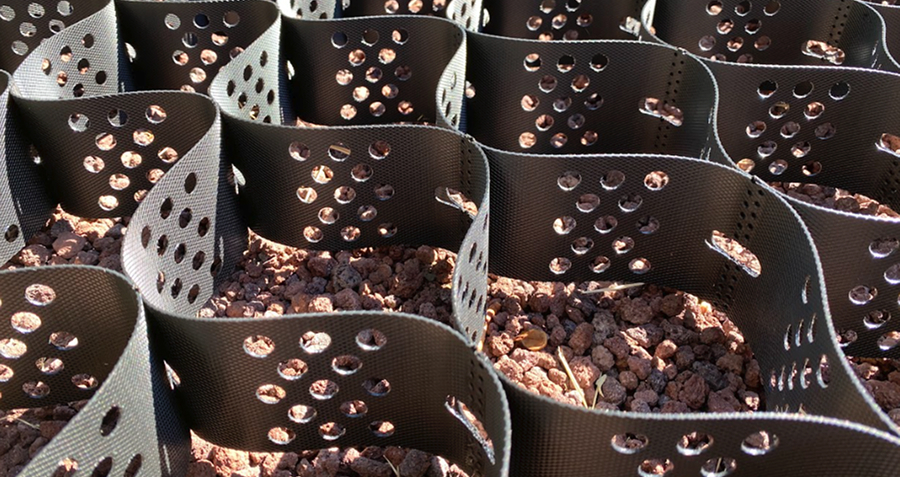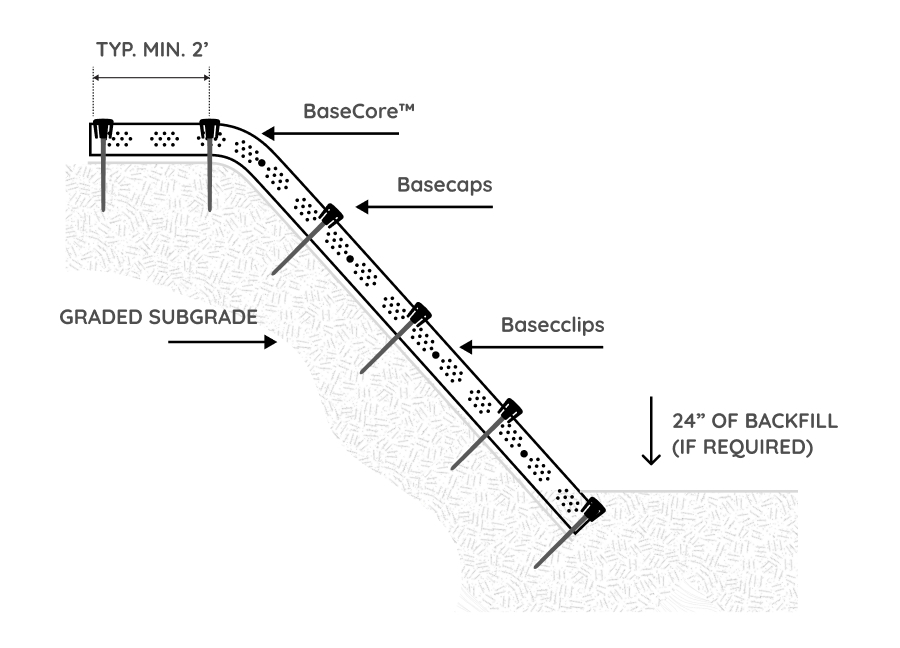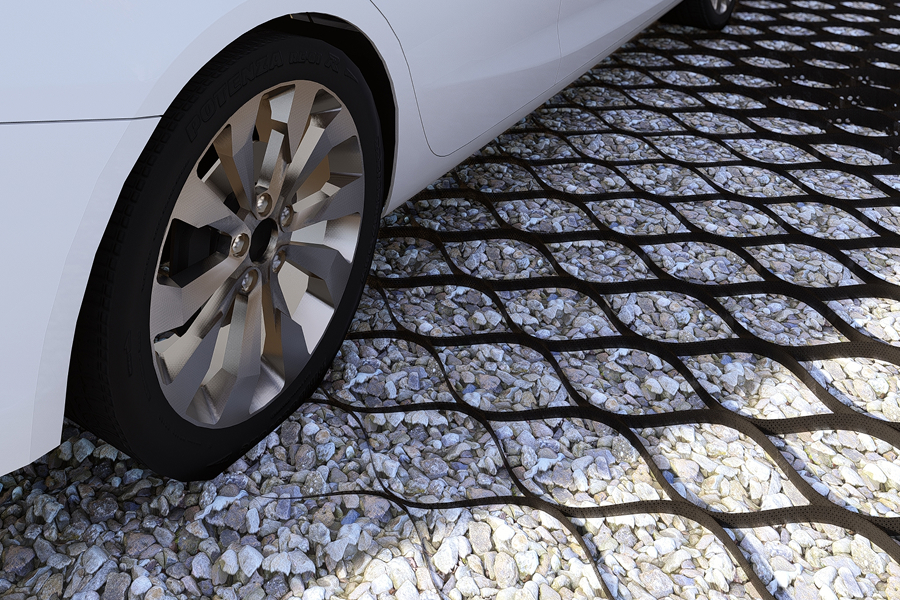The Accessibility Challenge for Modern Parking Lots
As a contractor or business owner, you’re likely familiar with the balancing act: creating parking facilities that are accessible to all, environmentally responsible, and cost-effective. Traditional asphalt has long been the default choice for ADA-compliant surfaces, but rising material costs, environmental concerns, and maintenance headaches are prompting many to seek alternatives.
What if you could build a parking lot that:
- Fully complies with ADA requirements
- Costs 50-70% less than asphalt
- Significantly reduces stormwater runoff
- Requires minimal maintenance
- Can be constructed with local materials

The good news? You can—with BaseCore HD geocell technology and properly stabilized gravel surfaces.
Understanding ADA Requirements for Parking Surfaces
The Americans with Disabilities Act (ADA) Standards for Accessible Design specify that ground surfaces along accessible routes must be:
- Stable: The surface doesn’t shift under applied force
- Firm: Resists deformation under pressure (such as wheelchair wheels)
- Slip-resistant: Provides adequate friction to prevent falls
Additionally, surfaces must be smooth enough for wheelchair travel without excessive vibration and free of level changes exceeding ¼ inch.
Contrary to popular belief, these requirements don’t mandate asphalt or concrete. The ADA is performance-based, not material-specific. What matters is how the surface performs—and properly stabilized gravel systems can deliver exactly what’s needed.
How BaseCore HD Transforms Gravel into an ADA-Compliant Surface
BaseCore HD uses cellular confinement technology—a honeycomb-like HDPE grid that, when filled with the proper aggregate, creates a unified, load-bearing surface that behaves more like pavement than gravel.

Here’s how the system works:
- The honeycomb cells prevent lateral movement of aggregate, eliminating rutting and spreading
- The cellular structure distributes vehicle loads more effectively, preventing deformation
- When filled with appropriate aggregate and compacted, the surface becomes firm and stable—comparable to traditional paving
The 3-6 inch deep cells can be filled with well-graded gravel (3/8″ minus crushed rock) or recycled materials like asphalt millings, then compacted to create a smooth, unified surface that supports everything from passenger vehicles to delivery trucks.
Scientific Validation of ADA Compliance
Independent testing has confirmed that properly installed geocell systems can meet ADA accessibility requirements. According to research:
- Stabilized gravel surfaces using cellular confinement technology have been shown to meet ASTM F1951 standards for wheelchair maneuverability in laboratory testing
- Independent testing by Beneficial Designs, Inc. found that similar geocell systems passed wheelchair accessibility standards
- Testing with rotational penetrometers (devices that measure surface firmness) has shown that well-compacted geocell surfaces can achieve firmness ratings comparable to asphalt
A study by the National Center on Accessibility (funded by the U.S. Access Board) found that compacted aggregate surfaces can meet ADA firmness and stability requirements when properly installed and maintained. The key is using the right materials and installation techniques.
Installation Best Practices for ADA Compliance
To ensure your BaseCore HD parking lot meets ADA standards, follow these critical guidelines:
1. Choose the Right Aggregate
CRITICAL: Use fine, well-graded aggregate (3/8″ minus with fines) as recommended by accessibility researchers and the U.S. Forest Service. This material compacts into a firm, cohesive surface that wheelchairs can traverse with minimal resistance.
Avoid:
- Coarse-only gravel mixtures
- Round pea gravel
- Loose stones without fines
2. Prepare a Proper Foundation
- Install a 4-6 inch compacted gravel base beneath the BaseCore HD system
- Ensure consistent compaction across the entire area
- Address any drainage issues in the subgrade before installation
3. Install and Fill BaseCore HD Correctly
- Secure panels according to manufacturer specifications
- Fill cells completely with approved aggregate
- Compact thoroughly using a plate compactor or roller
- Ensure the aggregate is flush with (or slightly above) the cell walls
4. Maintain Proper Grades for Accessibility
- Keep accessible parking spaces relatively flat (maximum 2% slope in any direction)
- Ensure smooth transitions at entrances to walkways
- Provide proper drainage without creating cross-slopes that exceed ADA limits

5. Implement a Maintenance Plan
While BaseCore HD systems require far less maintenance than asphalt, regular inspections are important to maintain ADA compliance:
- Inspect quarterly for any localized settling
- Reapply and compact additional aggregate as needed
- After winter, check for any plow damage or displacement
- Document maintenance to demonstrate ongoing compliance efforts
The BaseCore HD Advantage: Cost-Benefit Analysis
Cost Savings
Choosing BaseCore HD over traditional asphalt typically delivers:
- 30-50% lower installation costs: Less expensive materials and simpler installation process
- Reduced maintenance expenses: No crack sealing, pothole repair, or resurfacing
- Longer service life: Properly maintained systems can last decades without major reconstruction
- Lower stormwater management costs: Permeable surface may reduce or eliminate need for retention ponds or other infrastructure
Environmental Benefits
- Permeability: Allows rainwater to infiltrate, reducing runoff and supporting groundwater recharge
- Heat reduction: Light-colored gravel mitigates urban heat island effect compared to black asphalt
- Recyclability: Can be filled with recycled materials (asphalt millings, crushed concrete)
- Filtration: Helps filter pollutants as water percolates through the stone and soil
- Reduced carbon footprint: Less energy-intensive manufacturing and installation
Regulatory Advantages
- May not count against impervious coverage limits in zoning regulations
- Can help meet Low Impact Development (LID) requirements
- May qualify for stormwater credits or LEED points in green building projects
Real-World Success Stories
Commercial Application: Retail Overflow Parking
A retail development in the Pacific Northwest saved over $100,000 by using BaseCore HD for its overflow parking area. The 30,000 square foot lot remains ADA compliant while allowing 100% of rainfall to infiltrate on-site, eliminating the need for additional stormwater infrastructure.
Institutional Setting: Church Parking Expansion
A growing congregation needed to expand parking without triggering costly stormwater requirements. By choosing BaseCore HD with recycled asphalt millings, they created a fully accessible parking area that blended with the natural surroundings while saving approximately 40% compared to traditional asphalt.
Historic Site: Visitor Center Access
A historic site needed to provide accessible parking without disrupting the natural aesthetics. Similar to the Lincoln New Salem Historic Site project, BaseCore HD filled with locally-sourced crushed stone created ADA-compliant parking spaces that maintained the site’s character while meeting all accessibility requirements.

Implementation Guide for Contractors
Step 1: Site Assessment
- Evaluate existing conditions
- Test soil bearing capacity
- Determine drainage requirements
- Identify ADA-specific needs (number of spaces, routes to building)
Step 2: Material Selection and Sourcing
- Get your customized quote from BaseCore
- Identify local aggregate suppliers for infill material
- Arrange for proper testing of materials if required
Step 3: Site Preparation
- Excavate to proper depth
- Install geotextile fabric if required
- Prepare and compact base material
Step 4: Installation
- Layout and secure BaseCore HD panels
- Fill with appropriate aggregate
- Compact thoroughly
- Install ADA signage and markings
Step 5: Quality Control and Documentation
- Test surface firmness if required
- Document installation process
- Provide maintenance guidelines to owner
- Consider certification from a third-party accessibility consultant
Conclusion: The Smart Choice for Modern Parking Needs
BaseCore HD stabilized gravel surfaces represent the future of accessible parking—combining ADA compliance with environmental benefits and significant cost savings. For contractors and business owners facing rising material costs and increased environmental regulations, this innovative solution delivers the best of all worlds.
By following the guidelines outlined in this article and working with the BaseCore team, you can confidently offer clients a parking solution that meets or exceeds accessibility requirements while delivering substantial advantages over traditional asphalt.
Ready to learn more about how BaseCore HD can transform your next project? Contact our team today for a consultation, or download our complete technical specifications and installation guide.
